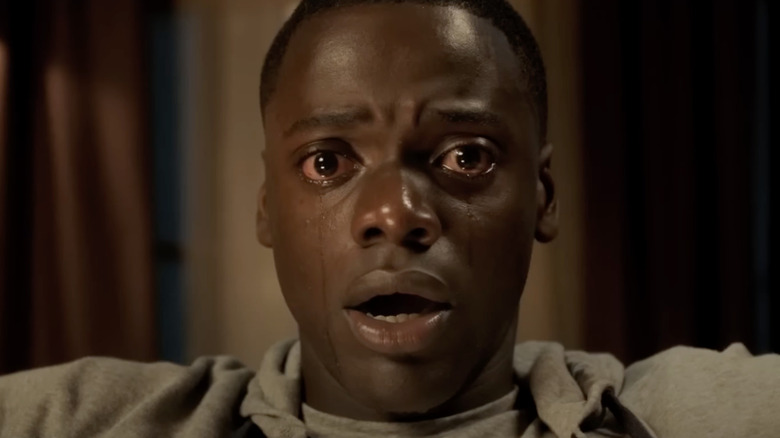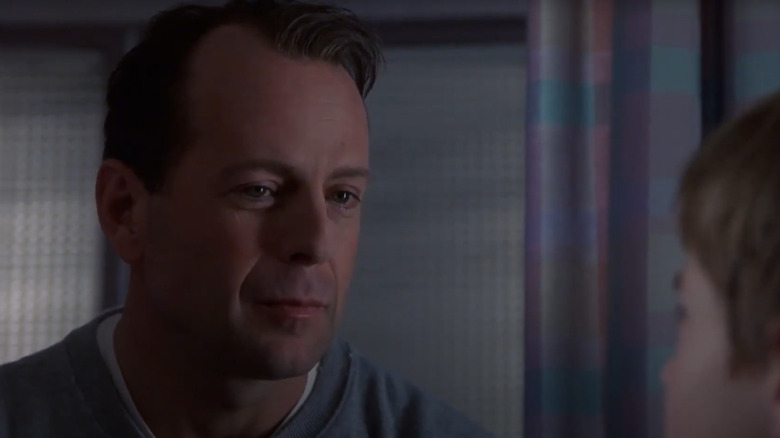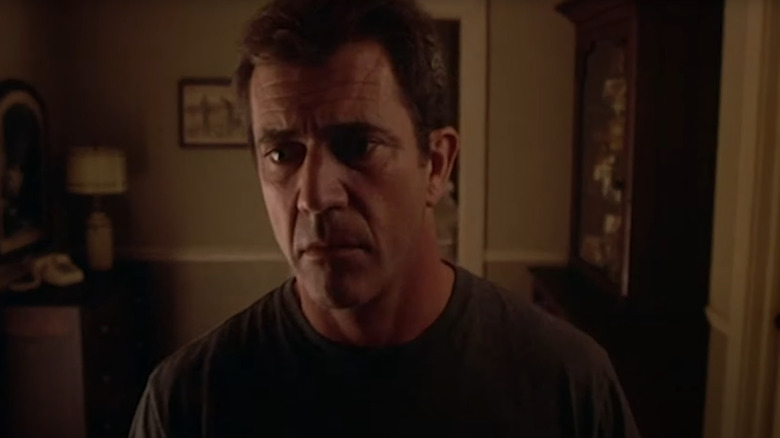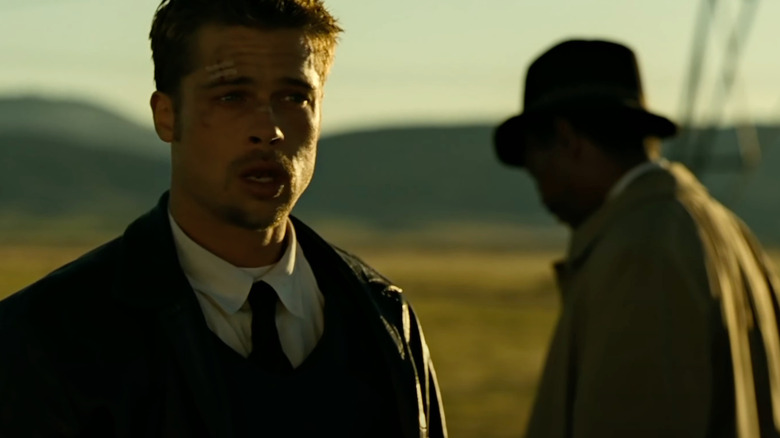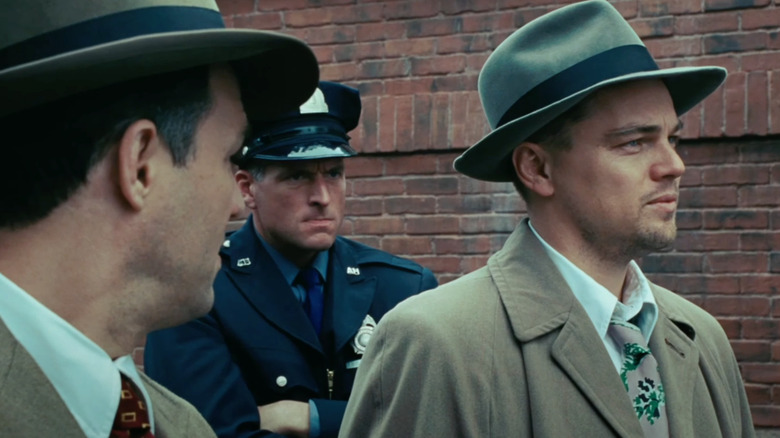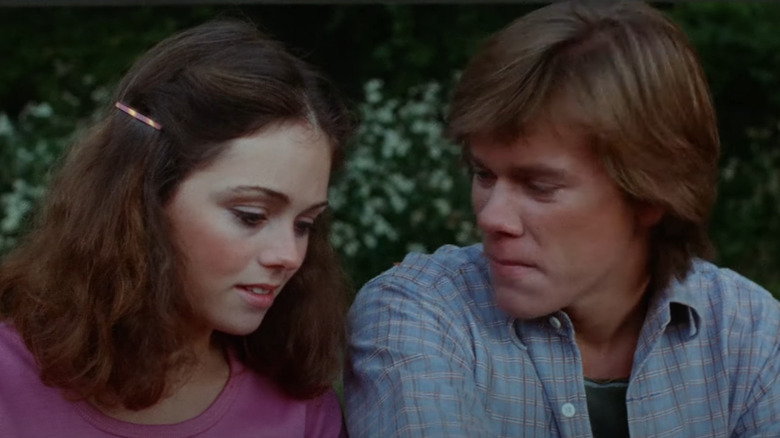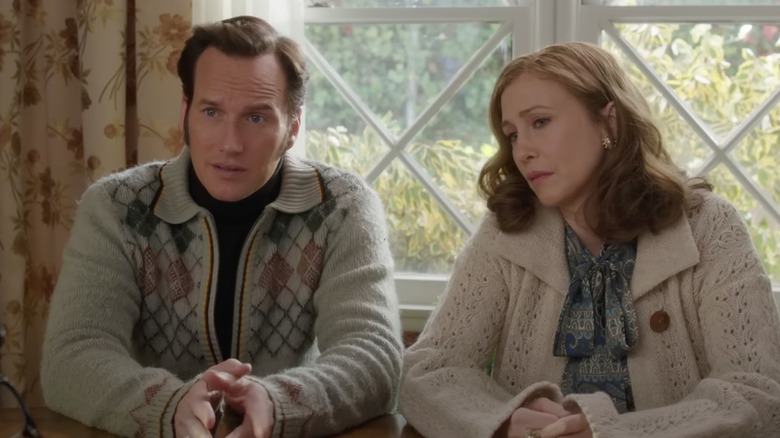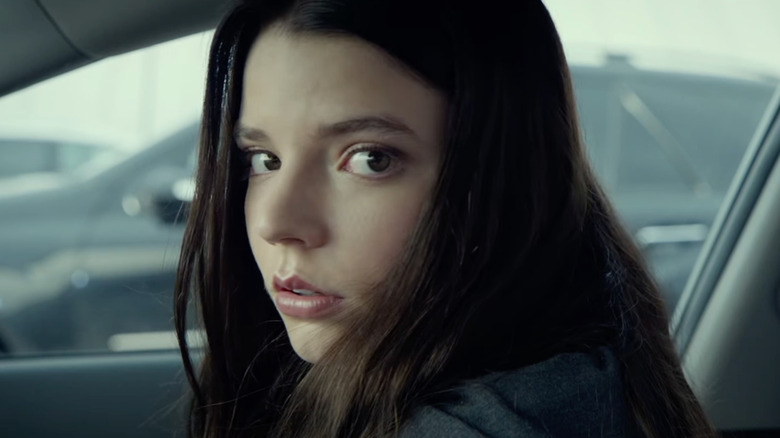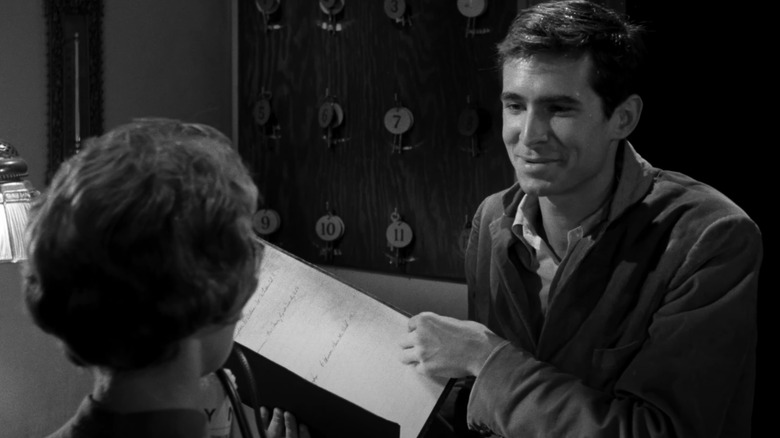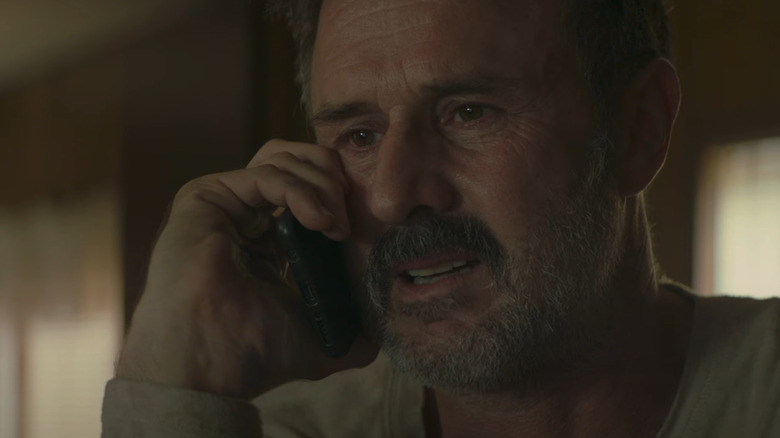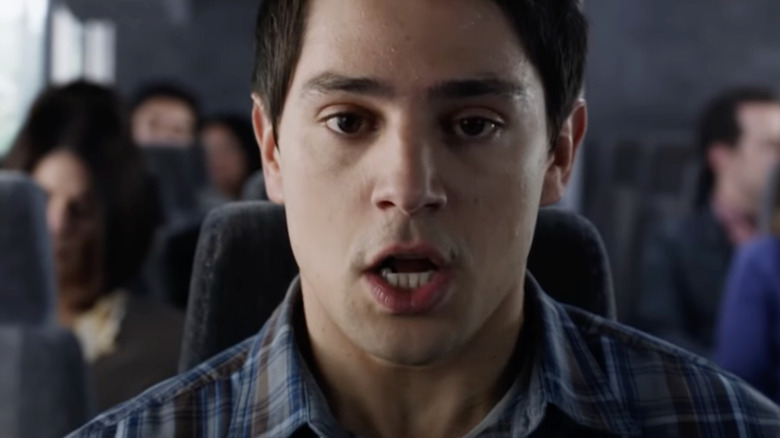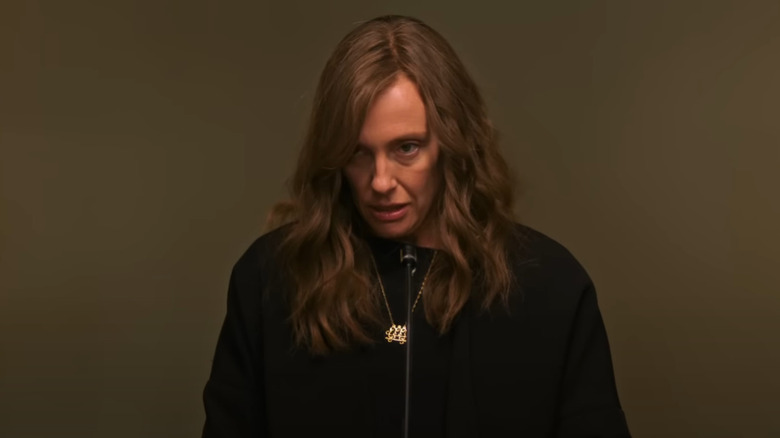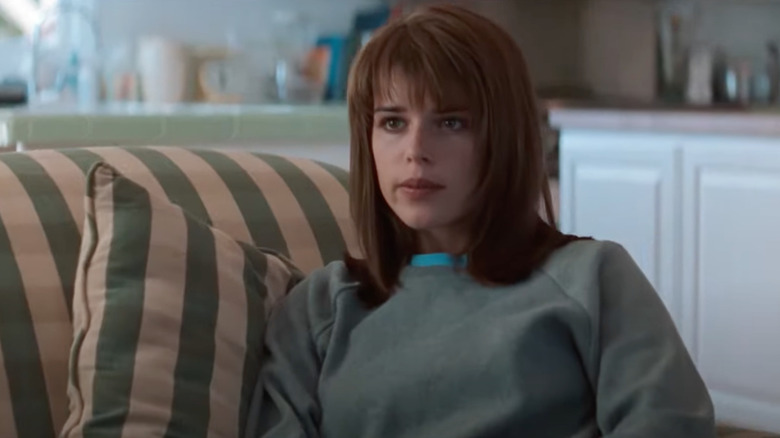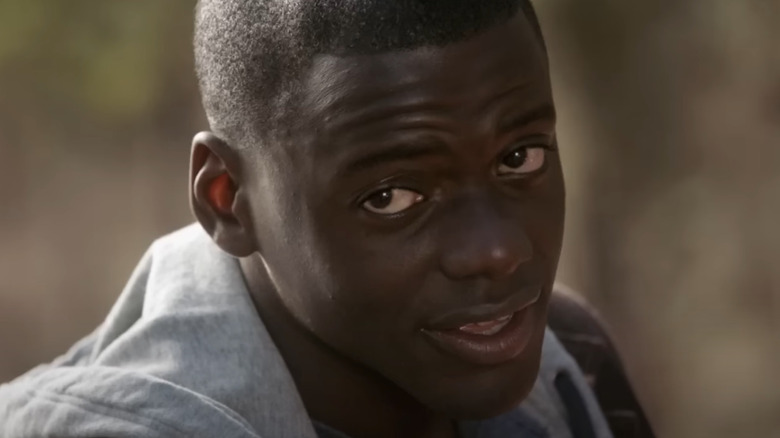Sneaky Clues Everyone Missed In Horror Movies
October brings many rewards, not the least of which is a slew of fantastic motion pictures to watch. I love a good horror movie, and the spooky season is the perfect time to bask in the morbid side of Hollywood and beyond. Whether you travel back in time to feast on Universal's classic monster series like "Frankenstein," "Dracula," and "Creature from the Black Lagoon" or indulge in modern fare such as "Hereditary," "Get Out," or "M3GAN," there's enough variety to please all but the pickiest of movie fans.
Moreover, most horror films require multiple viewings to fully appreciate, if only to catch all the sneaky Easter eggs and clues the filmmakers squeeze into every frame. Watch Jordan Peele's "Nope" again, and you'll pick up a hefty dose of not-so-subtle foreshadowing that'll make you respect the alien drama even more. Or take another look at any of M. Night Shyamalan's efforts and pay attention to the visual clues he uses to set up his twist endings.
Of course, if you're pressed for time, you can just read this list of the sneaky clues everyone missed in horror movies. I've already done all the legwork so you can spend the day wondering how you missed so many apparent details — and know what to look for next time you watch. Obviously, prepare for major spoilers about all these movies.
The Sixth Sense (1999)
By now, everyone knows about the twists in "The Sixth Sense" — unless you somehow don't, in which case you should stop reading now. In 1999, however, M. Night Shyamalan's spookfest caught everyone off-guard with its story of a boy who can see dead people. Wisely, the advertising revolved around this plot point, allowing Shyamalan to hide the film's biggest twist in plain sight.
At the end of "The Sixth Sense," we discover that Bruce Willis' character, Dr. Malcolm Crowe, died after sustaining a gunshot wound in the prologue. Various clues linger throughout the picture — some subtle, others not so much. During the famous "I see dead people" scene in which Cole (Haley Joel Osment) reveals his secret, he explains that these ghosts don't know they're dead, and the camera immediately cuts to Malcolm. He doesn't know he's dead, you see? Nobody catches this on the first viewing, but the brief cut is a sly clue to the big twist on subsequent watches.
There are other moments as well — namely, that no one other than Cole ever interacts with Malcolm. Midway through the film, Malcolm meets his wife Anna (Olivia Williams) for dinner, and she ignores him throughout. Shyamalan frames the scene as if her anger stems from his delay, but in reality, she can't see him. Instead, she drinks a glass of wine alone and quietly whispers "happy anniversary" before leaving the restaurant. Oh, and pay attention to the color red as it foreshadows Malcolm's condition.
Signs (2002)
M. Night Shyamalan became a household name thanks to "The Sixth Sense." Following the equally enthralling "Unbreakable," he switched back into horror for "Signs," a delightfully eerie alien invasion story tucked inside a larger tale about faith. Mel Gibson stars as Graham Hess, a former minister who ditched the church following his wife's death. An alien invasion causes him to question God's plan further and ask whether everything we do on Earth is preordained or chance. Are there signs for us to follow, or are we lingering on this planet without guidance, improvising our decisions?
Tellingly, he doesn't arrive at any definitive conclusion but certainly has his eyes opened when a handful of "coincidences" overlap and save his family. We see clues throughout the picture, notably how his daughter Bo (Abigail Breslin) leaves glasses of water around the house. As it turns out, water hurts the aliens. So, when one of them attacks, Graham and his brother Merrill (Joaquin Phoenix) smash the glasses with a baseball bat, causing water to spray on and wound the evil extraterrestrial.
Plenty of other "signs" prove vital in helping Graham and his family outlast the invasion and restore his faith in God, but Bo's strategically placed water glasses leave the most impact.
Seven (1995)
If you haven't seen David Fincher's diabolically twisted thriller, "Seven," then stop what you're doing and go watch it right now. The 1995 feature about a pair of detectives on a quest to bring down a killer known as John Doe remains one of the most gripping films ever produced, right down to its shocking conclusion.
In summary, protagonists David Mills (Brad Pitt) and William Somerset (Morgan Freeman) apprehend John Doe (Kevin Spacey) after he willingly walks into a police station. The threesome heads (pun intended) out to find his latest victim, hoping to end the madness. Instead, they get much more than expected when a box arrives containing the head of Mills' wife (Gwyneth Paltrow). Nothing prepares the viewer for this moment, as Mills' domestic life lingers on the periphery and has very little to do with the overarching narrative — until John Doe's devastating final move.
As it turns out, that ol' sly dog Fincher has been preparing audiences for the big reveal all along, particularly with a few shots of pictures in the books Somerset reads in the library. Specifically, there's a pair of images showing decapitated bodies. Talk about creepy. Also, when Mills shoots John Doe, a single frame of Paltrow's face fills the screen, presumably flashing through his mind when he pulls the trigger ... haunting stuff.
Shutter Island (2010)
Leonardo DiCaprio and Mark Ruffalo star in Martin Scorsese's "Shutter Island," a psychological drama in which a U.S. Marshal Teddy Daniels embarks on a dark journey to uncover the secrets of an asylum on a remote island. Right off the bat, viewers can tell that something's amiss, between the odd behavior of the security personnel and Daniels' ever-growing paranoia. It quickly becomes clear that the pieces don't add up — with good reason.
Daniels is an inmate on the island, incarcerated for killing his manic-depressive wife in response to her murdering their children. The episode left Teddy — or rather, Andrew Laeddis, the man he used to be — racked with such guilt that he created an alternate personality and buried the truth deep inside his mind. The entire film is an elaborate ruse to get Teddy to remember his real identity. Ruffalo poses as his partner, but is in reality a psychiatrist trying to determine if Teddy/Andrew needs lobotomization.
Keen-eyed viewers will have little problem seeing the twist, as Scorsese peppers the film with plenty of hints. In an early scene, we see Ruffalo's character fumble with his gun, a clear sign that he's not a police officer. In another bit, if you watch his character closely, you can see him directing the entire façade behind Teddy's back, telling background characters when to leave or obey one of Teddy's commands. You might spot these fleeting moments on the first watch, but if you don't, they're reason enough to return for a second round.
Friday the 13th (1980)
"Friday the 13th" too often gets lost among the formulaic sequels spurred by its success. For all its low-budget tricks, the original slasher featured a fun little mystery that built towards a shocking ending. After all the mumbo jumbo about Jason Voorhees, the killer turns out to be sweet old Pamela Voorhees, knitted sweater and all. That's right, she was the mysterious person running around setting traps and murdering full-grown men without breaking a sweat or being seen.
Who saw that twist coming? Not me. I was too captivated by the shocking deaths to wonder about the killer's identity. The twist might not have surprised me if I paid attention to the soundtrack. Composer Harry Manfredini sneaks a nifty spoiler into his novel score, giving away the ending. He created his signature "Ki Ki Ki, Ma Ma Ma" sound from a critical moment in the film when Pamela (channeling the spirit of Jason) maniacally shouts, "Kill her mommy!" Sure, he distorts the line enough to cover the dialogue, but the sound remains a finely tuned clue warning viewers to prepare for a very angry mommy.
The Conjuring 2 (2016)
I adore the "Conjuring" franchise. They're this generation's "Poltergeist," a ghost story scary enough to hold your attention but light enough to warrant multiple viewings. I've seen the entire series several times and continue to notice small tidbits with each viewing. More specifically, in "The Conjuring 2," director James Wan places the name of the demon Valak (Bonnie Aarons) for all to see ... provided you look hard enough.
Knowing the demon's name is essential to stopping it, and curiously, heroes Lorraine and Ed Warren (Vera Farmiga and Patrick Wilson) miss this obvious detail even when it's right there in broad daylight. In fact, the name can be spotted in three separate shots. First, after Ed reveals his painting of the Nun, he and his wife talk in the kitchen. Right behind Lorraine on the kitchen wall hangs a heart with a very pronounced "V." Underneath the heart, the letters "A-L-A-K" appear on a wood panel. In the same scene, we cut to Ed sitting in front of a window adorned with colorful decorations that — you guessed it — spell out the name Valak.
Later, Lorraine's daughter makes friendship bracelets that, upon closer inspection, likewise reveal the demon's name. Another shot shows the word spelled out on a bookshelf behind Lorraine. Imagine how much time the Warrens could have saved had they paid more attention to their surroundings!
Split (2016)
I remember watching "Split" for the first time and digging M. Night Shyamalan's audacious approach to the material. However, when a mid-credit scene popped up featuring Bruce Willis' "Unbreakable" character, thus placing "Split" in the same universe as Shyamalan's second feature, I merely shrugged. My brother spoiled the twist an hour before we went to the theater after accidentally reading a spoiler-filled headline out loud. I ruined the ending of "The Prestige" for him, so it was probably well-deserved payback.
Knowing what to expect allowed me to look for clues throughout the picture, and as it happened, I noticed a big one before I took my seat. Check out the poster for "Split," you'll see James McAvoy's mug riddled with cracks, as though we are looking at him through a broken mirror. Now, go and look at the poster for "Unbreakable." It features a nearly identical aesthetic, with broken glass separating Bruce Willis and Samuel L. Jackson. It's certainly not the most striking detail of all time, but it's a fun tidbit hinting at the larger shared universe between the two films.
Psycho (1960)
Oh boy, "Psycho" stands as one of the greats, an exciting exercise in terror that influenced a generation of filmmakers. Even if you already know the legendary twist — that Norman Bates shares his mind with his long-deceased, murderous mother — there's still plenty to admire here. From Alfred Hitchcock's incredible direction to Bernard Herman's classic score and Anthony Perkins' star-making performance, everything about "Psycho" screams classic.
Now, Hitchcock was quite the mad genius, often packing his pictures with sly humor or dark details hinting at unseen elements lingering offscreen. With "Psycho," he teased unsuspecting audiences with carefully worded lines that point straight to the ending for those paying attention.
As revealed in the final, Norman's mother died years before the film's events. Her decaying corpse sits in front of a window overlooking the Bates Motel. Norman's personality shifts from a meek, humble man to a violent killer on the turn of a dime — neither knows what the other is doing. Norman and Mother are essentially two different people. During a conversation early in the movie with the doomed Marion Crane (Janet Leigh), Norman hints at his mother's current state, explaining, "She's harmless. She's as harmless as one of those stuffed birds." Indeed, his mother is dead, her corpse frozen like a stuffed animal — a very on-the-nose primer for the madness to come.
Scream (2022)
It's hard to tell if the "Scream" movies are smart with their foreshadowing, or just incredibly lazy. The filmmakers provide so many vague details about the killer's identity that Ghostface could feasibly be anyone, and enough evidence would exist to justify the reveal. Still, in 2022's "Scream," directors Matt Bettinelli-Olpin and Tyler Gillett tip their hand by having everyone's favorite underdog, Dewey Riley (David Arquette), name the killer — or, at least, one of the killers — in an early conversation with Sam (Melissa Barrera) and Richie (Jack Quaid).
"Never trust the love interest," he says, nodding to Quaid's character, Richie. "They seem sweet, caring, supportive. Then welcome to act three where they're trying to rip your head off." Dewey speaks from experience, having watched his friend Sidney (Neve Campbell) survive attacks from boyfriends in the previous films. However, his warnings are spot-on. Richie is caring and supportive, deceptively so, but turns out to be one-half of a killer combo yearning to recreate the Woodsboro murders.
Dewey and the gang also point out other individuals as likely killers. Sadly, Dewey becomes one of Ghostface's victims when he doesn't heed his own advice.
Final Destination 5 (2011)
Count me among those who enjoy the "Final Destination" franchise. What started as a relatively low-budget slasher evolved into an entertaining, overtly morbid horror series featuring an abundance of death traps that are more clever than they had any right to be. The gist? In each film, a group of individuals evades death, thus angering the Grim Reaper, who subsequently creates elaborate scenarios to kill off the survivors.
"Final Destination 5" opens with Sam (Nicholas D'Agosto) and Molly (Emma Bell), among others, surviving a bridge catastrophe following a well-timed premonition. Death comes knockin' and executes the survivors one by one until only Sam and Molly remain. To celebrate, they board a plane to Paris and see Carter (Kerr Smith) and Alex (Devon Sawa) — two characters from the original "Final Destination" — arguing, realizing all too late that they're doomed to die in an explosion shortly after takeoff. So, the twist is that "Final Destination 5" is a prequel to the first film, something viewers might miss unless they're paying close attention.
See, the fifth film never explicitly states the date. Instead, small clues pop up here and there, notably that Sam wants to take a restaurant internship in Paris. You might also hear music from the early 2000s played over the radio and note the dated car models. There's even a brief shot of a gift certificate with a 2001 expiration date.
Hereditary (2018)
Everyone needs to see "Hereditary" at least once. Ari Aster's bonkers horror drama doesn't hold back and pummels the viewer with some of the grisliest, freakiest, and downright horrifying visuals ever committed to film. I'm unsure if I like the A24 production, but I can't shake it from my mind, even years after watching it.
For those who have seen it, you know that the film revolves around a Satanic cult's efforts to bring the demon Paimon into the world. Doing so requires many beheadings, ancient rituals, and a healthy supply of naked older people. At the conclusion, Annie (Toni Collette) succumbs to her grief and becomes possessed, chasing her son Peter (Alex Wolff) until he eventually kills himself. Then, he rises and follows his mother's headless floating corpse into a treehouse, where the evil cult worships him as Paimon in the flesh. Eh, it's weird — great, but weird.
Aster teases the finale early on by having Charlie (Milly Shapiro), Annie's troubled daughter (and Paimon's current corporal host), chop off bird heads — a foreshadowing of the terrible fate that awaits both of them. A mysterious symbol also appears throughout on necklaces worn by Annie and her mother, carved into the post along the side of the road that eventually kills Charlie, and hanging around Annie's friend Joan's house, among other places.
Scream (1996)
Wes Craven's love letter to the slasher genre, 1996's "Scream," still holds up despite its propensity for pop culture references and a never-ending assembly line of often bland sequels. The film follows Sidney Prescott (Neve Campbell) as she tries to solve a series of gruesome murders around her quaint little town. Expertly crafted set pieces poke fun at the genre while treading new ground. Ultimately, Sidney's boyfriend Billy (Skeet Ulrich) and his pal Stu (Matthew Lillard) are revealed to be behind the murders, their love of horror movies having fed Billy's desire for revenge against Sidney's mother for having an affair with his father. The shocking reveal only arrives after several twists, but in hindsight, the clues were there all along.
Early in the film, our main characters assemble outside their high school to discuss the murders. Eagle-eyed viewers will notice the thick, black, military-style boots worn by both Billy and Stu match those worn by Ghostface during his numerous blood-soaked escapades.
Costume designer Cynthia Bergstrom chose the boots for a specific reason. "We wanted the boots just to be really nondescript," she told Footwear News. "Could a woman wear these boots? I remember when I was seeking the boots, it was important that they also came in women's sizes." As for the scene where Billy and Stu wear the boots in plain sight, Bergstrom explained, "It was sort of like a red herring," meant to throw audiences off.
Get Out (2017)
In terms of killer modern horror, no film comes close to delivering edge-of-your-seat thrills like Jordan Peele's "Get Out." Part scary movie, part dark comedy, part social commentary, this 2017 shocker follows Chris Washington (Daniel Kaluuya) during a trip to meet the family of his girlfriend, Rose (Allison Williams). Arriving at the ritzy country estate, Chris discovers a horrifying secret — Rose's family uses a diabolical procedure known as The Coagula to place white people's minds into Black people's bodies. Yikes!
We must wait until the third act to learn the truth, but Peele sets up the big twist with clever details. In one scene, for example, a cop confronts Rose and Chris after they hit a deer with their car. Small talk ensues, and the cop asks to see Chris' ID, an order that prompts Rose to take action. "That doesn't make any sense," she snaps, noting that Chris wasn't driving the vehicle. Rose implies the cop is racist, forcing him to retreat to his patrol car.
As uncomfortable as the incident makes Chris, it cements their bond and assures him (and the audience) that she's on his side in whatever he's up against. However, we learn that Rose is in on The Coagula procedure and plans to hand Chris over to her family. The cop scene plays very differently on a second watch — she wasn't standing up for her boyfriend, but going out of her way to prevent a paper trail for authorities to follow once he goes missing.
